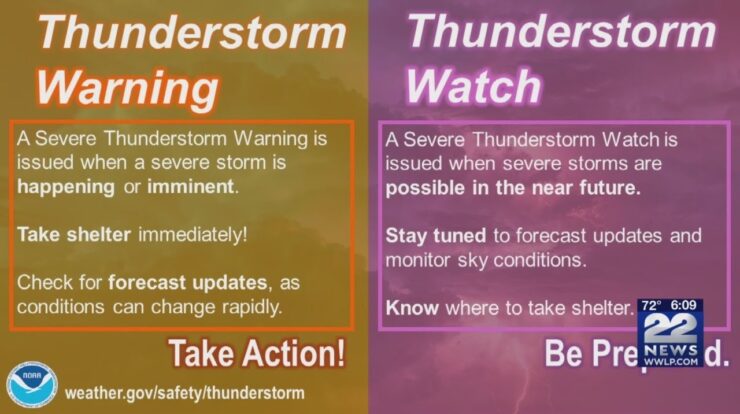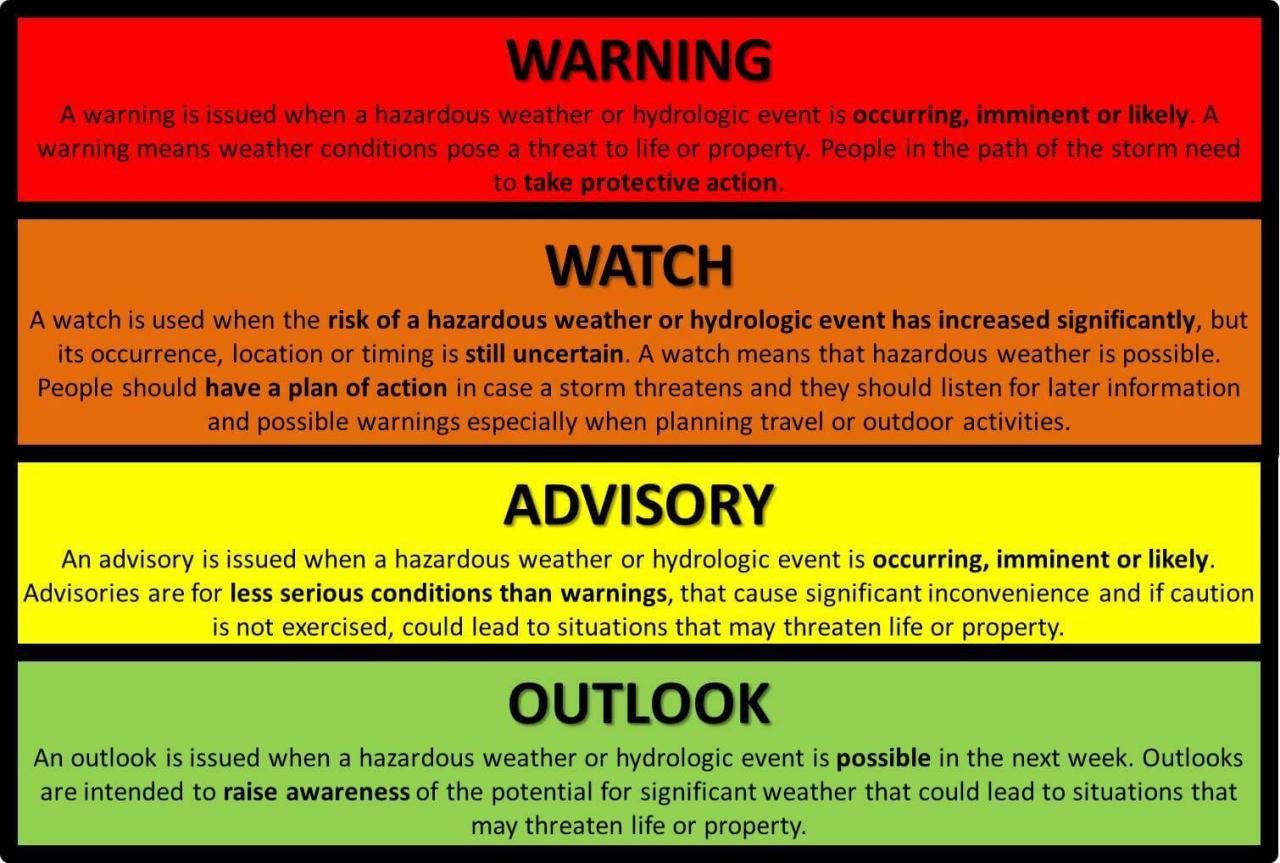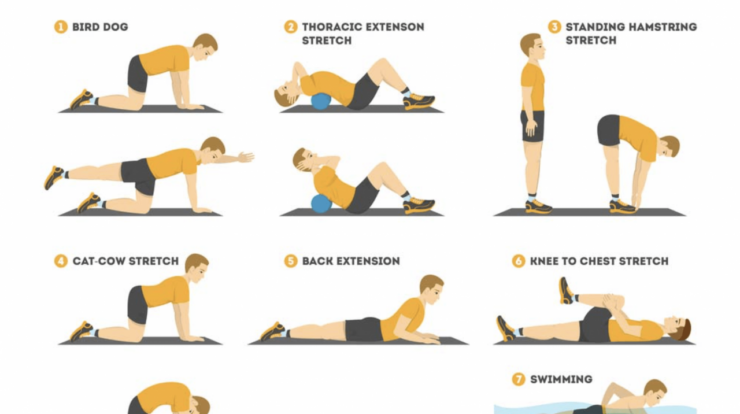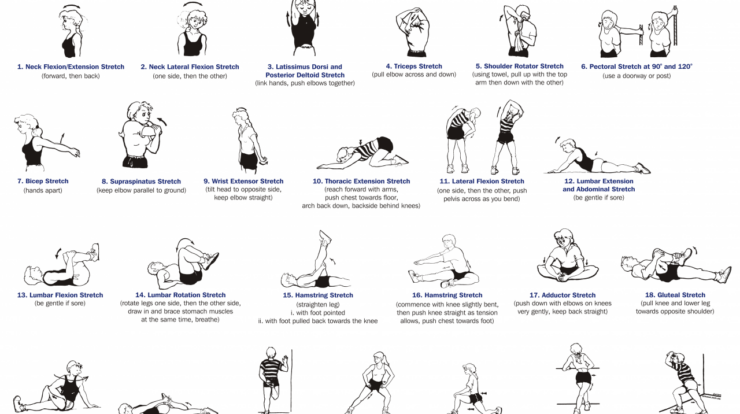
Is a watch or warning worse? This question arises when we encounter alerts that convey different levels of urgency. Watches and warnings are essential tools for disaster preparedness and response, but understanding their nuances is crucial for effective decision-making. In this exploration, we delve into the intricacies of these alerts, examining their severity, issuing authorities, public response, and impact on decision-making.
Watches typically indicate a potential threat, providing an early heads-up to prepare for possible action. Warnings, on the other hand, signal an imminent danger, prompting immediate action to protect life and property. The severity of each alert depends on the nature and proximity of the hazard.
Severity Comparison
A watch and a warning are two levels of weather advisories that indicate different levels of severity and potential danger. Understanding the difference between these advisories is crucial for taking appropriate precautions and staying safe during severe weather events.
The Lakers are set to face off against the White House Correspondents’ Dinner in a highly anticipated matchup. The Lakers have been in a slump lately, but they’ll be looking to turn things around against a tough opponent. The White House Correspondents’ Dinner is known for its star-studded guest list and political humor, so it’s sure to be a memorable event.
A watchis issued when conditions are favorable for severe weather to develop. It does not mean that severe weather is imminent, but it serves as a heads-up to stay alert and monitor the situation. On the other hand, a warningis issued when severe weather is either occurring or is expected to occur very soon.
It indicates a more immediate threat and requires immediate action to seek shelter or take other safety measures.
Examples of situations where a watch would be appropriate include when atmospheric conditions are ripe for thunderstorms, tornadoes, or flash floods, but there is no immediate threat. A warning, on the other hand, would be issued when a severe thunderstorm or tornado has been spotted or is approaching, or when heavy rainfall is expected to cause flash flooding.
The potential consequences of ignoring a watch are lower compared to ignoring a warning. While a watch indicates a potential threat, it does not guarantee that severe weather will occur. However, ignoring a warning can put you in immediate danger, as severe weather may be imminent or already happening.
Issuing Authority
The entities responsible for issuing watches and warnings vary depending on the country or region. In the United States, the National Weather Service (NWS) is the primary authority for issuing weather advisories.
The difference between watch and warning can be confusing, especially during severe weather events. A watch means that conditions are favorable for a particular hazard, while a warning means that the hazard is imminent or already occurring. Understanding the difference between watch and warning can help you stay safe during dangerous weather situations.
The NWS uses a set of criteria to determine when to issue a watch or a warning. A watch is issued when atmospheric conditions indicate that severe weather is possible within the next 12 to 24 hours. A warning is issued when severe weather is either occurring or is expected to occur within the next hour.
Clear communication and coordination between weather agencies are essential to ensure timely and accurate issuance of watches and warnings. This coordination helps prevent confusion and ensures that the public receives consistent and reliable information.
Public Response
The expected public response to a watch is to stay informed and monitor the situation. People should listen to local weather forecasts, be aware of changing weather conditions, and prepare for potential severe weather by having an emergency plan in place.
In contrast, a warning indicates a more immediate threat and requires immediate action. Upon receiving a warning, people should seek shelter in a sturdy building, away from windows and doors. They should also stay informed about the latest weather updates and follow any instructions from local authorities.
The severity of the message can significantly influence behavior. A watch serves as a reminder to stay alert, while a warning triggers a sense of urgency and prompts people to take immediate action.
Impact on Decision-Making

Watches and warnings play a crucial role in decision-making processes during severe weather events. They provide valuable information that helps individuals, businesses, and organizations make informed decisions about their safety and operations.
The timing and accuracy of watches and warnings can significantly affect outcomes. Timely issuance of warnings can provide ample time for people to take protective measures, reducing the risk of injury or damage. Conversely, inaccurate or delayed warnings can lead to confusion and complacency, increasing the likelihood of negative consequences.
Throughout history, watches and warnings have influenced countless decision-making processes. For example, during the 2005 Hurricane Katrina disaster, timely warnings allowed many people to evacuate and seek safety, reducing the number of casualties.
Mitigation Strategies: Is A Watch Or Warning Worse
To mitigate the impact of watches and warnings, several steps can be taken. Preparation and response plans are crucial. These plans should Artikel the actions to be taken in the event of a watch or warning, including evacuation routes, shelter locations, and communication protocols.
Technology also plays a significant role in enhancing mitigation efforts. Weather apps and alert systems provide real-time updates and notifications, helping people stay informed and respond quickly to severe weather events.
Case Studies
Numerous real-world examples of watches and warnings have been issued throughout history. One notable example is the issuance of a tornado warning in Joplin, Missouri, in 2011. The warning provided timely notice to residents, allowing them to seek shelter and avoid injury.
Another example is the issuance of a hurricane watch in the Caribbean in 2017. The watch gave residents ample time to prepare for the approaching storm, resulting in a successful evacuation and minimizing the impact of the hurricane.
When it comes to severe weather, it’s important to know the difference between watch and warning . A watch means that conditions are favorable for a particular hazard, while a warning means that the hazard is imminent or already occurring.
Understanding the difference between watch and warning can help you stay safe during dangerous weather situations.
Analyzing the effectiveness of watches and warnings in these case studies can provide valuable lessons learned and best practices for future severe weather events.
Staying informed about the latest news is essential, especially during unpredictable events like hurricanes. The lakers watch provides real-time updates on tropical storms and hurricanes, helping you prepare and stay safe. Similarly, the white house correspondents dinner watch offers an exclusive look into the annual gathering of journalists and politicians, giving you insights into the political landscape.
Back to the topic of hurricanes, the lakers watch is an invaluable resource for tracking storm paths and intensity. By understanding the difference between watch and warning , you can make informed decisions about when to take precautions. The difference between watch and warning lies in the level of threat posed by an approaching storm, helping you prioritize your safety measures.
Last Word

Navigating the complexities of watches and warnings requires clear communication, timely issuance, and an informed public. By understanding the differences between these alerts, we can better prepare for and respond to potential threats, safeguarding our communities and minimizing the impact of disasters.
FAQ Guide
What is the difference between a watch and a warning?
A watch indicates a potential threat, while a warning signals an imminent danger.
Who issues watches and warnings?
Watches and warnings are typically issued by government agencies responsible for disaster management and weather forecasting.
How can I stay informed about watches and warnings?
Monitor official weather and emergency alert channels, such as websites, social media, and local news.






